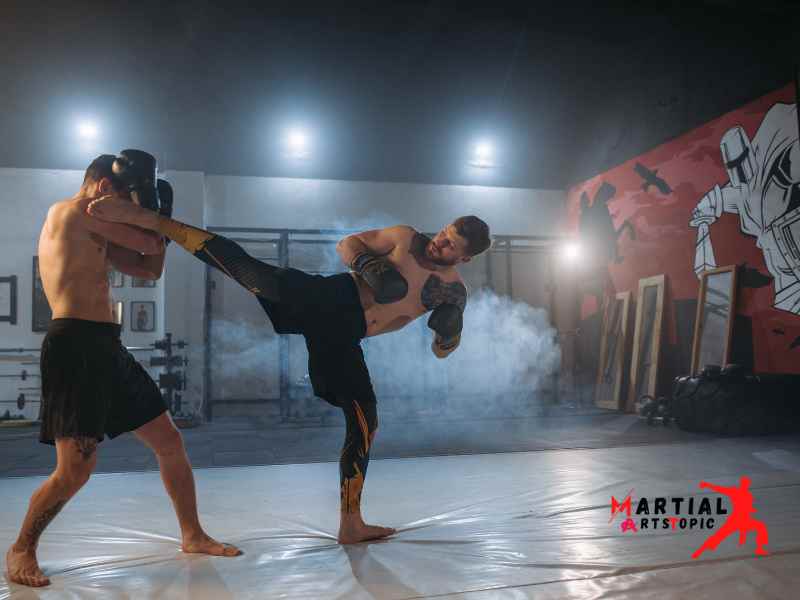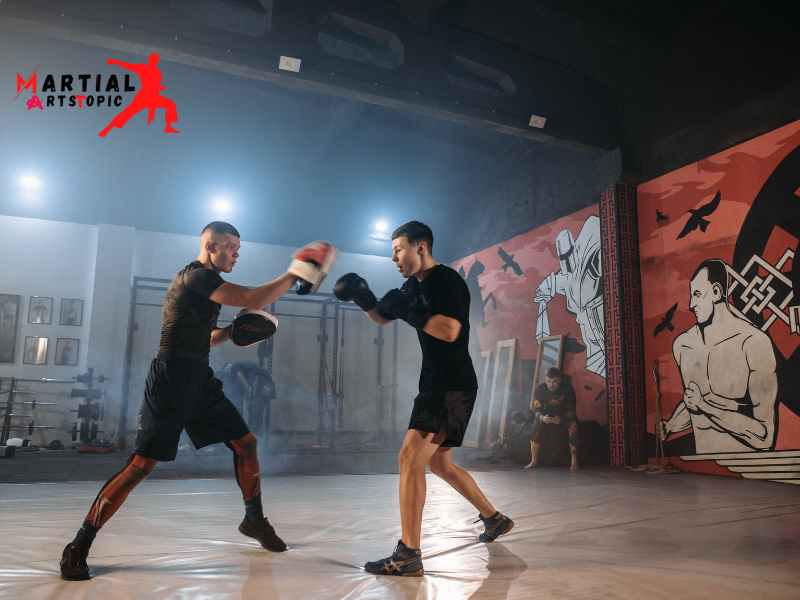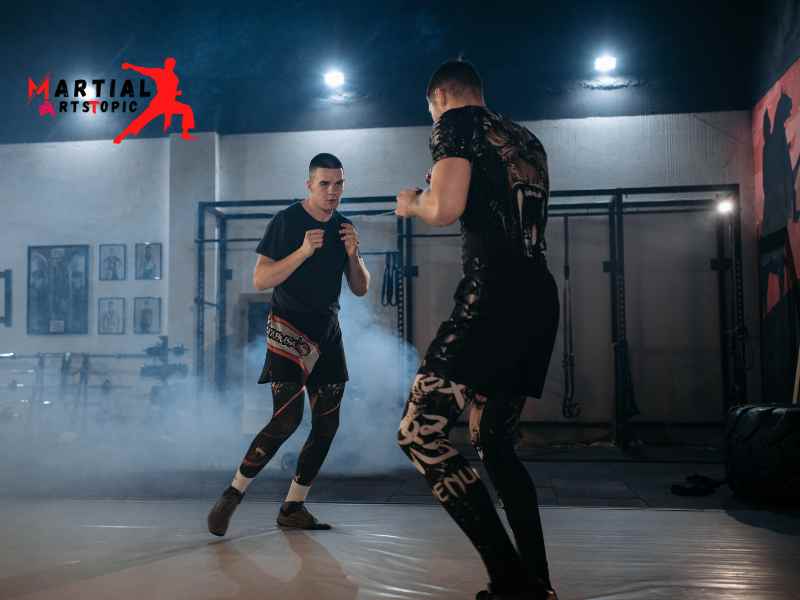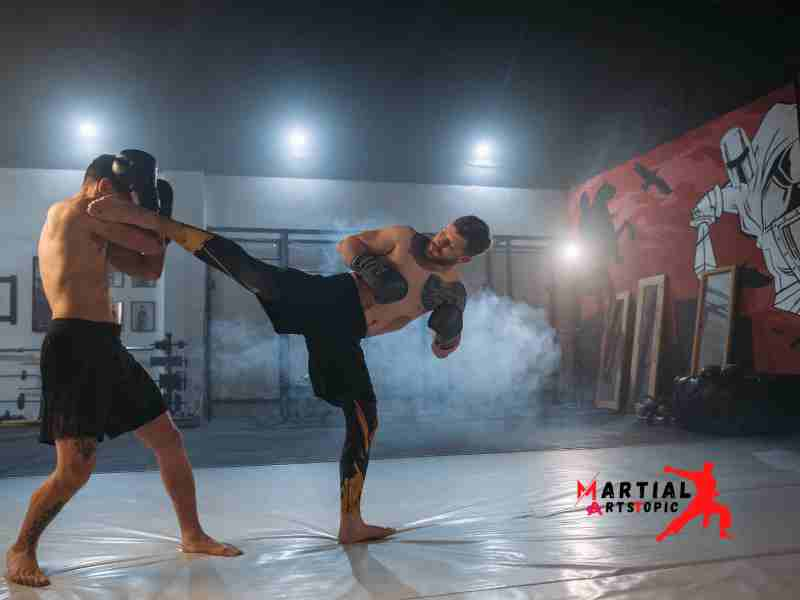
What is Sanshou? Unveiling the Power.
What is Sanshou? Sanshou, also known as Sanda, is a Chinese martial art that combines full-contact kickboxing with wrestling, takedowns, throws, and sweeps. It is a dynamic and practical fighting system that emphasizes both striking and grappling techniques, making it a comprehensive martial art for self-defense and combat sports. Sanshou originated from traditional Chinese martial arts and has developed into a modern combat sport with structured rules and regulations. Practitioners of Sanshou develop agility, strength, and strategic thinking while learning to effectively defend themselves in real-life situations. Its focus on practicality and adaptability makes it a valuable martial art for individuals seeking a well-rounded and functional approach to self-defense and combat training.
The Art of Sanshou: Its Origins and History
What is Sanshou? Its Origins and History Sanshou, also known as Sanda, is a Chinese martial art that combines striking techniques with takedowns and throws. This dynamic and versatile combat sport has a rich history that dates back centuries, and it continues to captivate practitioners and enthusiasts around the world. In this blog post, we will delve into the origins and history of Sanshou, shedding light on its cultural significance and evolution over time.
Origins of Sanshou
The origins of Sanshou can be traced back to ancient China, where it was developed as a comprehensive fighting system for military training. The art form draws influence from various Chinese martial arts styles, including Kung Fu, Shuai Jiao (Chinese wrestling), and Qin Na (joint locking techniques). Sanshou was specifically designed to equip soldiers with the necessary skills to engage in hand-to-hand combat on the battlefield.
Historical Development
Over the centuries, Sanshou underwent several transformations and adaptations, reflecting the changing needs and priorities of different eras. During the Ming Dynasty (1368-1644), Sanshou became an integral part of military training, focusing on practical techniques that could be employed during warfare. It emphasized powerful strikes, efficient takedowns, and quick recoveries to maintain agility on the battlefield.
In the late Qing Dynasty (1644-1912), Sanshou began to develop into a popular sport for public entertainment. It was during this time that rules and regulations were established to ensure fair competition and spectator safety. Sanshou matches became a common form of entertainment in festivals and gatherings, showcasing the skill and prowess of martial artists.
Modern Sanshou

In the 20th century, Sanshou went through another significant transformation as it adapted to the modern era. With the rise of competitive combat sports, Sanshou developed into a full-contact sport, incorporating elements of Western boxing and kickboxing. This modern form of Sanshou gained popularity in the 1980s and 1990s, with the establishment of international Sanshou competitions and organizations.
Today, Sanshou is practiced and taught worldwide, with dedicated training centers and competitions held in various countries. The art form continues to strengthen, with practitioners constantly refining and expanding the techniques and strategies involved. We can attribute its popularity to its practicality, effectiveness, and the physical and mental discipline it instills in its practitioners.
Cultural Significance
Beyond its practical applications, Sanshou carries significant cultural value in Chinese society. It embodies the principles of discipline, respect, and self-improvement that are deeply rooted in Chinese philosophy and traditions. Sanshou training not only develops physical strength and combat skills but also cultivates mental fortitude, resilience, and personal growth.
The Future of Sanshou
As Sanshou gains recognition and popularity globally, its future looks promising. With the advancement of technology and increased accessibility to training resources, they expose more people to the art form and have the opportunity to practice and compete. Sanshou has the potential to become a mainstream combat sport, captivating audiences with its thrilling displays of skill, athleticism, and strategic prowess.
The Art of Sanshou: The Ancient Chinese Martial Art
What is Sanshou? The Ancient Chinese Martial Art In the vast world of martial arts, there are numerous disciplines that have been developed over centuries. One such discipline is Sanshou, an ancient Chinese martial art that has gained popularity all around the world. In this blog post, we will delve into the rich history and techniques of Sanshou, also known as Sanda, and explore why it continues to captivate martial artists and enthusiasts alike.
Originating in China, Sanshou combines elements of traditional Chinese boxing (Kung Fu) and various combat styles like kickboxing, wrestling, and grappling. They often referred it to as “Chinese kickboxing” due to its focus on striking techniques, kicks, punches, and throws. Unlike other martial arts where the emphasis is solely on technique, Sanshou also emphasizes practical application in real-world combat situations.
We can trace the origins of Sanshou back to ancient times when Chinese soldiers needed effective fighting skills for hand-to-hand combat on the battlefield. Over time, these techniques were refined and adapted for civilian self-defense purposes. Today, Sanshou has evolved into a competitive sport, with athletes showcasing their skills in international tournaments such as the World Wushu Championships.
One of the defining characteristics of Sanshou is its versatility. Unlike some martial arts that focus on a specific aspect of combat, Sanshou practitioners learn to seamlessly transition between striking and grappling techniques. This well-rounded approach makes Sanshou an excellent choice for self-defense as it prepares individuals for various combat scenarios.
The training methods in Sanshou are designed to enhance speed, power, agility, and endurance. Practitioners often engage in rigorous conditioning exercises, including intense cardio workouts, strength training, and sparring sessions. These training methods not only improve physical fitness but also develop mental discipline, focus, and resilience.
In a Sanshou match, competitors wear protective gear, including helmets, gloves, and shin guards. Something typically divide matches into rounds, and the objective is to score points by executing strikes, takedowns, and throws while avoiding being hit or taken down. The dynamic nature of Sanshou matches makes them thrilling to watch, with athletes employing a wide range of techniques to outwit and overpower their opponents.
Beyond its physical benefits, Sanshou also promotes values such as respect, discipline, and self-control. They encouraged practitioners to cultivate a strong mind-body connection, fostering a sense of harmony and balance within themselves. This holistic approach to martial arts contributes to personal growth and self-improvement, making Sanshou not just a sport but a way of life.
Whether you are a martial arts enthusiast or someone interested in self-defense, Sanshou offers a unique and comprehensive training experience. Its rich history, versatility, and practical application make Sanshou a valuable addition to anyone’s martial arts journey. So why not explore the ancient Chinese art of Sanshou and discover the beauty, power, and grace it has to offer.
Sanshou Techniques: Tips and Tricks for Success
Sanshou Techniques: Tips and Tricks for Success Are you passionate about Sanshou? Do you want to take your skills to the next level and become a master of this martial art? Look no further! Whether you’re a beginner or an experienced practitioner, these techniques will surely enhance your performance and take you closer to your goals.
- Focus on Strength and Conditioning: Sanshou requires a high level of physical fitness. To improve your performance, it is crucial to focus on strength and conditioning exercises. Incorporate weight training, cardio workouts, and flexibility exercises into your routine. Building powerful muscles and increasing your endurance will give you an edge in the ring.
- Master the Basics: Sanshou is all about mastering the basics. Spend ample time perfecting your stance, footwork, and punches. Practice the fundamental kicks, such as the front kick, roundhouse kick, and sidekick, until they become second nature. Remember, a sound foundation is the key to mastering advanced techniques.
- Develop Speed and Accuracy: Sanshou is a fast-paced martial art that requires quick reflexes and precision. Work on improving your speed and accuracy by practicing drills that focus on speed punching, rapid kicks, and quick takedowns. Speed and accuracy will give you the upper hand during competitions and sparring sessions.
- Enhance Your Agility: Agility is essential in Sanshou as it allows you to move swiftly and dodge your opponent’s attacks. Incorporate agility exercises, such as ladder drills, cone drills, and plyometric exercises, into your training routine. Agility training will not only improve your footwork, but also enhance your overall coordination and reaction time.
- Master Defense Techniques: Defense is just as important as offense in Sanshou. Learn effective blocking and evading techniques to protect yourself from your opponent’s strikes. Practice parrying, slipping, and countering techniques to develop a well-rounded defense strategy. Remember, a powerful defense can save you from potentially dangerous situations.
- Improve Your Clinching Skills: Clinching is a unique aspect of Sanshou that sets it apart from other martial arts. Mastering clinching techniques will allow you to control your opponent, execute powerful throws, and score points. Work on your clinching skills by practicing drills that involve grip fighting, off-balancing, and executing takedowns from the clinch.
- Mental Preparation: Sanshou is not just a physical battle; it is also a mental one. Develop mental resilience and focus through meditation and visualization techniques. Visualize yourself executing flawless techniques, winning matches, and overcoming challenges. Cultivating a strong mindset will help you stay calm and composed during intense competitions.
- Spar Regularly: Spar with partners of different skill levels to challenge yourself and improve your techniques. Regular sparring sessions will allow you to apply what you’ve learned in a realistic setting and test your skills against different opponents. It will also help you identify areas that need improvement and refine your strategy.
- Seek Guidance from Experts: To truly main Sanshou, seek guidance from experienced instructors or coaches. They can provide valuable insights, correct your technique, and guide you through advanced training methods. Learning from experts will ensure that you are on the right path to success.
- Stay Consistent and Dedicated: Last but not least, consistency and dedication are essential for mastering Sanshou. Set realistic goals, create a training schedule, and stick to it. Practice regularly and stay committed to your training. Remember, progress takes time, but with consistent effort, you will see significant improvements in your Sanshou skills.
Sanshou Training Tips and Drills

Sanshou Training Tips and Drills: Boost Your Skills in the Martial Art Are you looking for ways to enhance your Sanshou skills? Look no further! In this comprehensive blog post, we will provide you with valuable training tips and drills to elevate your Sanshou game to the next level. Whether you are a beginner or an experienced martial artist, they guarantee these techniques to improve your performance and technique.
Sanshou, also known as Sanda, is a Chinese martial art that combines elements of kickboxing, wrestling, and self-defense techniques. It emphasizes both striking and grappling, making it a well-rounded combat sport. By incorporating these training tips and drills into your routine, you will develop strength, agility, and reflexes, allowing you to become a formidable Sanshou practitioner.
- Master the Basics: Fundamental techniques are the building blocks of Sanshou. Ensure that you have a solid foundation in striking, kicking, and footwork. Practice your punches and kicks with precision, focusing on technique rather than power initially. Perfecting your basics will make your advanced moves more effective.
- Conditioning is Key: Sanshou demands physical fitness, so it is essential to train your body accordingly. Incorporate cardiovascular exercises like running, skipping rope, and high-intensity interval training (HIIT) to improve your stamina and endurance. Additionally, strength training exercises such as weightlifting and bodyweight exercises will build muscle and enhance your overall power.
- Balance and Core Stability: Sanshou requires excellent balance and core stability for effective strikes and takedowns. Incorporate exercises like planks, squats, and single-leg balance drills into your routine to strengthen your core and improve your stability. This will not only enhance your performance but also reduce the risk of injury.
- Develop Speed and Agility: Speed and agility are crucial in Sanshou to outmaneuver your opponents. Incorporate agility ladder drills, cone drills, and shuttle runs into your training regime to improve your quickness and reaction time. These drills will enhance your footwork and enable you to move swiftly during bouts.
- Partner Drills: Sanshou is a combat sport, and practicing with a partner is essential. Engage in partner drills that focus on both striking and grappling. Work on combinations, counters, and takedowns together, ensuring that you both get equal practice. This will help you develop timing and coordination while simulating real fight scenarios.
- Bag Work: Utilize heavy bags, speed bags, and focus mitts to enhance your striking techniques. Practice various combinations, strikes, and kicks to develop power, speed, and precision. Bag work is an excellent way to improve your conditioning while refining your technique.
- Sparring: To truly test your skills, engage in controlled sparring sessions. This will allow you to apply your techniques in a realistic setting while challenging your reflexes and decision-making abilities. Sparring also helps develop your timing, distance management, and strategy.
Remember, safety should always be a priority when participating in Sanshou training. Ensure that you have adequate protective gear such as mouthguards, gloves, shin guards, and headgear. Additionally, always warm-up and stretch before each training session to prevent injuries.
By incorporating these Sanshou training tips and drills into your routine, you will witness significant improvements in your technique, strength, and overall performance. Train consistently, stay motivated, and seek guidance from experienced coaches to excel in this dynamic martial art. So, what are you waiting for? Step into the dojo and start your journey towards becoming a skilled Sanshou practitioner today!
The Benefits of Practicing Sanshou for Self-Defense
The Benefits of Practicing Sanshou for Self-Defense Are you looking for an effective self-defense system? Look no further, because Sanshou might be the answer you’ve been searching for. Sanshou, also known as Sanda, is a Chinese martial art that combines striking, kicking, throwing, and wrestling techniques. In this blog post, we will explore the benefits of practicing Sanshou for self-defense and why it is gaining popularity worldwide.
Practical and Real-World Techniques
One of the primary benefits of training in Sanshou for self-defense is its focus on practical techniques. Unlike some traditional martial arts that may rely heavily on complex forms or stylized movements, Sanshou emphasizes real-world combat scenarios. Through rigorous training, practitioners learn how to effectively strike, grapple, and defend themselves in various situations, making it a highly practical and reliable self-defense system.
Full-Body Workout
Another advantage of practicing Sanshou is the intense physical workout it provides. Sanshou training involves a combination of striking techniques, kicks, throws, and wrestling, which engage multiple muscle groups simultaneously. This full-body workout not only improves strength, flexibility, and endurance but also enhances overall fitness and body coordination.
Mental Discipline and Focus
Sanshou training requires mental discipline and focus, as practitioners need to react quickly and make split-second decisions during combat situations. Through regular practice, individuals develop mental toughness, improved concentration, and enhanced situational awareness. These mental attributes can be valuable not only in self-defense scenarios but also in everyday life.
Confidence Building
Self-confidence is a crucial element when it comes to self-defense. Sanshou training helps build confidence by teaching effective techniques and strategies for dealing with potential threats. As practitioners gain proficiency in Sanshou, they become more self-assured in their ability to protect themselves, leading to increased confidence in all areas of life.
Stress Relief and Emotional Well-being
Engaging in physical activity, such as Sanshou training, is an excellent way to reduce stress and promote emotional well-being. The release of endorphins during exercise can improve mood, reduce anxiety, and alleviate symptoms of depression. Sanshou training provides an outlet for pent-up emotions and can serve as a healthy and productive way to manage stress.
Heightened Self-Awareness
Practicing Sanshou cultivates self-awareness, both physically and mentally. By constantly challenging themselves and pushing their limits, practitioners develop a better understanding of their bodies’ capabilities and limitations. This increased self-awareness can help individuals identify potential weaknesses and work towards improving them, leading to personal growth and self-improvement.
Practical Self-Defense Skills
Ultimately, the primary benefit of practicing Sanshou for self-defense is acquiring practical and effective self-defense skills. Sanshou techniques are designed to be efficient and suitable for real-world situations. Whether facing an attacker or dealing with a potential threat, Sanshou equips individuals with the necessary tools to defend themselves effectively and confidently.
The Evolution of Sanshou: From Traditional to Modern Combat

The Evolution of Sanshou: From Traditional to Modern Combat Sanshou, also known as Sanda, is a Chinese martial art that has a rich history and a fascinating evolution. Combining elements of striking, wrestling, and takedowns, Sanshou has become a popular combat sport that showcases the effectiveness of Chinese martial arts techniques. In this blog post, we will explore the journey of Sanshou from its traditional roots to its modern form, highlighting the changes and developments that have shaped this dynamic martial art.
Traditional Sanshou: A Battlefield Art
Sanshou has its origins in ancient China, where it was primarily used as a military combat system. They developed it to equip soldiers with practical fighting skills for hand-to-hand combat on the battlefield. Traditional Sanshou training focused on conditioning the body, enhancing physical strength, and honing techniques that could be applied in actual combat situations.
One of the distinguishing features of traditional Sanshou was its emphasis on practicality and efficiency. Techniques were designed to be simple yet effective, enabling practitioners to neutralize opponents quickly and decisively. Strikes, kicks, punches, and throws formed the core of traditional Sanshou, with an emphasis on close-range combat and rapid transitions between different techniques.
Modern Sanshou: The Birth of a Combat Sport
In the early 20th century, as China underwent social and political changes, martial arts began to develop from a military art to a means of promoting physical fitness and national identity. This transformation also influenced Sanshou, leading to the development of a modern, competitive version of the martial art.
The modernization of Sanshou can be attributed in part to the efforts of the Chinese government, which sought to promote Chinese martial arts both within the country and internationally. The establishment of standardized rules and regulations for Sanshou competitions helped to formalize the sport and make it more accessible to a wider audience.
Modern Sanshou competitions follow a set of rules that prioritize safety and fair play. Fighters wear protective gear, including headgear, gloves, and padded clothing, to minimize the risk of serious injury. They typically hold matches in a ring or a designated area, with rounds lasting a specified duration. They awarded points based on the effectiveness of strikes, takedowns, and throws, with the aim of scoring more points than the opponent by the end of the match.
The Influence of Other Combat Sports
As Sanshou gained popularity worldwide, it began to incorporate elements from other combat sports, further enriching its techniques and strategies. The influence of disciplines such as boxing, kickboxing, and Muay Thai can be seen in the striking techniques used in modern Sanshou.
The incorporation of wrestling and grappling techniques from disciplines like judo and Brazilian Jiu-Jitsu has also broadened the range of techniques available to Sanshou practitioners. This integration of different combat styles has made Sanshou a more versatile and well-rounded martial art, allowing fighters to adapt to various situations and opponents.
Sanshou Today: A Thriving Combat Sport
Today, Sanshou continues to thrive as a competitive combat sport, with both national and international tournaments showcasing the skill and athleticism of its practitioners. It has gained recognition as an effective and dynamic martial art, attracting fighters from different backgrounds and styles.
The evolution of Sanshou from its traditional roots to its modern form is a testament to the adaptability and resilience of Chinese martial arts. While it has developed to meet the demands of modern combat sport, Sanshou still retains its essence as an effective fighting system.
Whether you are a martial arts enthusiast or simply interested in the evolution of combat sports, Sanshou offers a fascinating journey through history and technique. As it continues to evolve, Sanshou’s influence will undoubtedly shape the future of martial arts, both in China and around the world.
Sanshou vs. Other Martial Arts: What Sets it Apart
Sanshou vs. Other Martial Arts: What Sets it Apart When it comes to martial arts, there is an abundance of styles and disciplines to choose from. Each has its own unique techniques, philosophies, and training methods. One martial art that stands out from the rest is Sanshou. In this blog post, we will explore what sets Sanshou apart from other martial arts.
Versatility and Practicality
One of the key features that sets Sanshou apart from other martial arts is its versatility and practicality. While many martial arts focus on specific aspects of combat, such as striking or grappling, Sanshou integrates various techniques into a cohesive system. Practitioners learn how to strike effectively, defend against strikes, and execute takedowns and throws. This versatility makes Sanshou an effective martial art for self-defense and real-life combat situations.
Full-Contact Sparring
Another distinguishing aspect of Sanshou is its emphasis on full-contact sparring. Unlike some martial arts that limit contact or rely heavily on forms and patterns, Sanshou practitioners engage in live sparring where they can test their techniques in a realistic setting. This full-contact training allows practitioners to develop their timing, speed, and accuracy, preparing them for real combat scenarios.
Striking and Kicking Techniques
Sanshou places a strong emphasis on striking and kicking techniques. Practitioners learn a wide range of strikes, including punches, elbows, knees, and kicks. These techniques are not only powerful but also highly effective in close-quarter combat. Sanshou practitioners develop strong and precise striking skills through rigorous training and constant practice.
Throws and Takedowns
Unlike many striking-focused martial arts, Sanshou incorporates throws and takedowns into its repertoire. This makes it particularly useful in situations where close-quarters combat is necessary or when facing opponents with a grappling background. Sanshou practitioners learn how to execute swift and effective throws, enabling them to control and subdue opponents quickly.
Adaptability and Continuous Improvement
Sanshou is a martial art that values adaptability and continuous improvement. It encourages practitioners to be open-minded, learn from different disciplines, and adapt their techniques to different situations. This mindset allows Sanshou practitioners to evolve and refine their skills over time, making them well-rounded martial artists.
er you are a fan of combat sports or a practitioner looking to enhance your skills, Sanshou is undoubtedly a style worth exploring.
In conclusion
Sanshou is a highly effective martial art that combines various techniques from different disciplines, making it a well-rounded combat system. With its focus on striking, kicking, throwing, and grappling, Sanshou provides practitioners with a comprehensive set of skills for self-defense and competition. The emphasis on practical application and real-world scenarios ensures that practitioners are well-prepared to handle any situation they may encounter. Whether one is looking to improve their fitness, learn self-defense, or compete in combat sports, Sanshou offers a dynamic and engaging training experience. Through its rigorous training methods and emphasis on discipline and respect, Sanshou not only molds the body but also instills valuable qualities such as perseverance, determination, and mental fortitude. Overall, Sanshou is a martial art that can benefit individuals of all ages and skill levels, providing a pathway to personal growth, physical fitness, and self-confidence.
